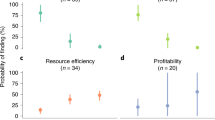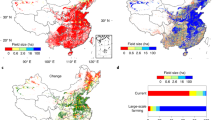Abstract
Farm number and size are deemed important for a variety of social and environmental outcomes, including yields, input use efficiencies, biodiversity, crop diversity, climate change and concentration of power in food systems. Using a model incorporating theoretical drivers of the creation and consolidation of farms within countries, I historically reconstruct the number of farms on Earth over 1969–2013 and predict their future evolution. I show that under current development trajectories, the number of farms globally will probably decline from the current 616 million (95% CI: 495–779 million) in 2020 to 272 million (95% CI: 200–377 million) by the end of the twenty-first century, with average farm size doubling. In some regions, such as Europe and North America, we will see a continued decline from recent history, whereas in other regions, including Asia, Middle East and North Africa, Oceania, and Latin America and the Caribbean, we will see a turning point from farm creation to widespread consolidation. The turning point also occurs for sub-Saharan Africa, but much later in the century. This world in which significantly fewer large farms replace numerous smaller ones carries major rewards and risks for the human species and the food systems that support it.
This is a preview of subscription content, access via your institution
Access options
Access Nature and 54 other Nature Portfolio journals
Get Nature+, our best-value online-access subscription
$29.99 / 30 days
cancel any time
Subscribe to this journal
Receive 12 digital issues and online access to articles
$119.00 per year
only $9.92 per issue
Buy this article
- Purchase on Springer Link
- Instant access to full article PDF
Prices may be subject to local taxes which are calculated during checkout




Similar content being viewed by others
Data availability
The datasets used and created in this study are archived at the Zenodo public: https://doi.org/10.5281/zenodo.7856053.
Code availability
All code for reproducing the results in this manuscript are archived at the Zenodo public: https://doi.org/10.5281/zenodo.7856053.
References
Ramankutty, N. et al. Trends in global agricultural land use: implications for environmental health and food security. Annu. Rev. Plant Biol. 69, 789–815 (2018).
Ellis, E. C. Land use and ecological change: a 12,000-year history. Annu. Rev. Environ. Resour. 46, 1–33 (2021).
Lowder, S. K., Skoet, J. & Raney, T. The number, size, and distribution of farms, smallholder farms, and family farms worldwide. World Dev. 87, 16–29 (2016).
Lowder, S. K., Sánchez, M. V. & Bertini, R. Which farms feed the world and has farmland become more concentrated? World Dev. 142, 105455 (2021).
Ricciardi, V., Mehrabi, Z., Wittman, H., James, D. & Ramankutty, N. Higher yields and more biodiversity on smaller farms. Nat. Sustain. 4, 651–657 (2021).
Clapp, J. The problem with growing corporate concentration and power in the global food system. Nat. Food 2, 404–408 (2021).
Nyström, M. et al. Anatomy and resilience of the global production ecosystem. Nature 575, 98–108 (2019).
Herrero, M. et al. Farming and the geography of nutrient production for human use: a transdisciplinary analysis. Lancet Planet. Health 1, e33–e42 (2017).
Wu, Y. et al. Policy distortions, farm size, and the overuse of agricultural chemicals in China. Proc. Natl Acad. Sci. USA 115, 7010–7015 (2018).
Ricciardi, V., Ramankutty, N., Mehrabi, Z., Jarvis, L. & Chookolingo, B. How much of the world’s food do smallholders produce? Glob. Food Sec. 17, 64–72 (2018).
Garzón Delvaux, P. A., Riesgo, L., Gomez, Y. & Paloma, S. Are small farms more performant than larger ones in developing countries? Sci. Adv. 6, eabb8235 (2020).
Eastwood, R., Lipton, M. & Newell, A. Farm Size in Handbook of Agricultural Economics (eds Evenson, R. & Pingali, P.) 3323–3397 (Elsevier, 2010).
Jayne, T. S., Chamberlin, J. & Headey, D. D. Land pressures, the evolution of farming systems, and development strategies in Africa: a synthesis. Food Policy 48, 1–17 (2014).
Taylor, J. E. & Martin, P. L. in Handbook of Agricultural Economics (eds Gardner, B. L. & Rausser, G. C.) 457–511 (Elsevier, 2001).
Dellink, R., Chateau, J., Lanzi, E. & Magné, B. Long-term economic growth projections in the shared socioeconomic pathways. Glob. Environ. Change 42, 200–214 (2017).
Kc, S. & Lutz, W. The human core of the shared socioeconomic pathways: population scenarios by age, sex and level of education for all countries to 2100. Glob. Environ. Change 42, 181–192 (2017).
Adamopoulos, T. & Restuccia, D. The size distribution of farms and international productivity differences. Am. Econ. Rev. 104, 1667–1697 (2014).
Duan, J. et al. Consolidation of agricultural land can contribute to agricultural sustainability in China. Nat. Food 2, 1014–1022 (2021).
Hazel, P. When and How Should Agricultural Insurance Be Subsidized? (International Finance Corporation and International Labour Organization, 2017).
Swanson, B. E. Global Review of Good Agricultural Extension and Advisory Service Practices (UN FAO, 2008).
Barrett, C. B. Overcoming global food security challenges through science and solidarity. Am. J. Agric. Econ. 103, 422–447 (2021).
Collier, P. & Dercon, S. African agriculture in 50 years: smallholders in a rapidly changing world? World Dev. 63, 92–101 (2014).
Satterthwaite, D., McGranahan, G. & Tacoli, C. Urbanization and its implications for food and farming. Phil. Trans. R. Soc. B 365, 2809–2820 (2010).
Mehrabi, Z., Gill, M., Wijk, M., van, Herrero, M. & Ramankutty, N. Livestock policy for sustainable development. Nat. Food 1, 160–165 (2020).
Egli, L., Mehrabi, Z. & Seppelt, R. More farms, less specialized landscapes, and higher crop diversity stabilize food supplies. Environ. Res. Lett. 16, 055015 (2021).
Mehrabi, Z. & Ramankutty, N. Synchronized failure of global crop production. Nat. Ecol. Evol. 3, 780–786 (2019).
Garibaldi, L. A. et al. Working landscapes need at least 20% native habitat. Conserv. Lett. 14, e12773 (2021).
Snapp, S. S., Blackie, M. J., Gilbert, R. A., Bezner-Kerr, R. & Kanyama-Phiri, G. Y. Biodiversity can support a greener revolution in Africa. Proc. Natl Acad. Sci. USA 107, 20840–20845 (2010).
Abson, D. J. et al. Leverage points for sustainability transformation. Ambio 46, 30–39 (2017).
Gorgan, M. & Hartvigsen, M. Development of agricultural land markets in countries in eastern Europe and central Asia. Land Use Policy 120, 106257 (2022).
Meyfriodt, P. et al. Ten facts about land systems for sustainability. Proc. Natl Acad. Sci. USA 119, e2109217118 (2022).
World Programme for the Census of Agriculture (FAO, 2020); https://www.fao.org/world-census-agriculture/en/
FAOSTAT (FAO, 2016); https://www.fao.org/faostat/en/#home
SSP Database Version 2.0 (SSP, 2020); https://tntcat.iiasa.ac.at/SspDb/dsd?Action=htmlpage&page=10
Fasiolo, M., Wood, S. N., Zaffran, M., Nedellec, R. & Goude, Y. Fast calibrated additive quantile regression. J. Am. Stat. Assoc. 116, 1402–1412 (2021).
Perrin, E. On some dangers of extrapolation. Biometrika 3, 99–103 (1904).
Acknowledgements
I thank M. Fasiolo for statistical advice and N. Ramankutty and the Land Use and Global Environment Laboratory for constructive feedback. Portions of this work were funded by a start-up grant from the University of Colorado, Boulder.
Author information
Authors and Affiliations
Corresponding author
Ethics declarations
Competing interests
The author declares no competing interests.
Peer review
Peer review information
Nature Sustainability thanks John-Oliver Engler, Jordan Chamberlin and the other, anonymous, reviewer(s) for their contribution to the peer review of this work.
Additional information
Publisher’s note Springer Nature remains neutral with regard to jurisdictional claims in published maps and institutional affiliations.
Supplementary information
Supplementary Information
Supplementary Figs. 1–6 and Table 1.
Rights and permissions
Springer Nature or its licensor (e.g. a society or other partner) holds exclusive rights to this article under a publishing agreement with the author(s) or other rightsholder(s); author self-archiving of the accepted manuscript version of this article is solely governed by the terms of such publishing agreement and applicable law.
About this article
Cite this article
Mehrabi, Z. Likely decline in the number of farms globally by the middle of the century. Nat Sustain 6, 949–954 (2023). https://doi.org/10.1038/s41893-023-01110-y
Received:
Accepted:
Published:
Issue Date:
DOI: https://doi.org/10.1038/s41893-023-01110-y
This article is cited by
-
Multidecadal dynamics project slow 21st-century economic growth and income convergence
Communications Earth & Environment (2023)
-
Balancing the trade-offs between land productivity, labor productivity and labor intensity
Ambio (2023)



